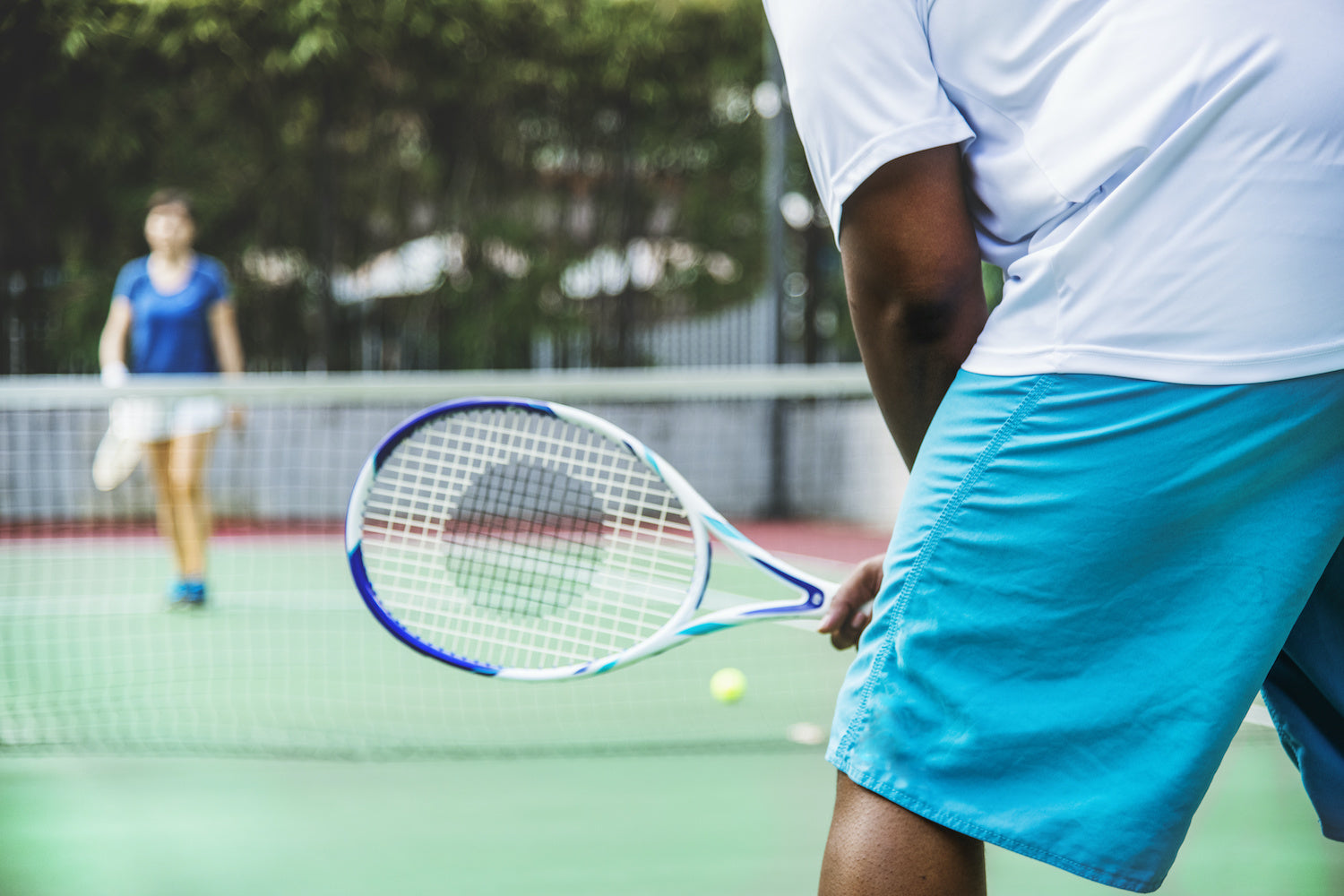
As tennis fans around the world tune into the 2020 US Open, tennis injury headlines from 2019’s event resurface: Shoulder injury knocks out defending champion Novak Djokvic. Injured Roger Federer ousted by Grigor Dimitrov.
Even the pros sometimes fall victim to the most common tennis injuries. The legendary Federer even admits he cannot play tennis forever. Though conditions like tennis elbow and patellar tendinitis can be painful, the proper training and knowledge about the most common tennis injuries can help even amateur tennis players prevent tennis injuries and play without discomfort.
Generally, maintaining an optimal level of fitness, using quality tennis equipment and getting proper rest post-match are key ways to prevent the most common tennis injuries. But playing this high-intensity sport comes with risks. Read on for an overview of the most common tennis injuries, their signs and symptoms and how to prevent and treat them.
Avoiding and Treating Tennis Elbow (Lateral Epicondylitis)

Tennis elbow, or lateral epicondylitis, is caused by inflammation of the forearm muscles and tendons on the outside of the elbow. According to Medical News Today, half of all tennis players will experience tennis elbow, making it one of the most common tennis injuries.
Repetitive motions of the wrist and arm – like repeated use of a backhand stroke with poor technique – are usually to blame for tennis elbow. It can be very painful and radiate to even your forearm and wrist. Tennis elbow can make it difficult to complete everyday actions, like holding a cup of coffee or turning a door knob.
To prevent tennis injuries like tennis elbow, stick to the middle of your arm’s range of motion, being careful not to bend or straighten your arm all the way during a swing. Use your whole lower body to power your stroke, not just your arms. Ask a coach for help with form, or stick to a two-handed backstroke to avoid putting strain on one arm.
If you find yourself dealing with the pain of tennis injuries like tennis elbow, be sure to rest and ice the area at home. Avid tennis players may treat serious cases of tennis elbow with soft-tissue massage and other muscle-stimulation techniques. Physical therapy to strengthen the shoulders, upper arms and abdominal muscles can also help. Find more tips for tennis elbow treatment here.
Prevent Rotator Cuff Tendinitis

Rotator cuff tendinitis is another one of the most common tennis injuries, especially in amateur players. It is defined by pain and swelling in the shoulder area and sometimes limited motion or weakness of the arm. Rotator cuff tendinitis tends to develop over time with repeated stress on the cuff. If left untreated, rotator cuff tendinitis can result in a partially or completely torn tendon.
Unfortunately for tennis enthusiasts, the demands placed on the shoulder joint in a tennis match can sometimes be too much on the rotator cuff muscles, a typically weak group of muscles that absorbs the force and slows the forward motion of the serving arm.
Prevention of rotator cuff tendinitis requires exercises to strengthen shoulder muscles. A regimen to build endurance, like this one, may help tennis players avoid succumbing to shoulder tennis injuries like rotator cuff tendinitis.
Rest, ice and physical therapy are typical treatments for rotator cuff tendinitis. Pay attention to shoulder pain and take a step away from tennis as needed to allow rotator cuff tendinitis to heal. Otherwise, a torn cuff could call for surgery.
Take Smart Steps (and Jumps) to Avoid Patellar Tendinitis

Patellar tendinitis (knee pain) is not just one of the most common tennis injuries; it afflicts athletes in just about every sport. Inflammation of the patellar tendon just below the kneecap is often caused by overuse, especially repetitive jumping in sports like tennis that causes microscopic tearing and injury of the tendon. The pain from patellar tendinitis – also called jumper’s knee – can worsen over time and interfere with your ability to play. (Just ask Rafael Nadal.)
Prevention of patellar tendinitis involves listening to your body and stopping play as soon as you feel pain. Strengthening thigh muscles helps alleviate the stress put on the knee that can cause patellar tendinitis. Finally, improving jumping and landing techniques can help you avoid knee pain on the court.
Treatment of patellar tendinitis begins with P.R.I.C.E.: Protection, Rest, Icing, Compression and Elevation. After pain resolves, stretching and strengthening exercise can help restore normal function and prevent recurrence of one of the most common tennis injuries. In severe cases of patellar tendinitis, surgery may be required.
Minimize and Heal Low Back Pain from Tennis

Tennis is tough on the back. Acute and chronic low back pain are some of the most common injuries impacting players, even pros like Andre Aggasi. The storied tennis giant battled chronic back pain throughout much of his professional tennis career, until he retired from the sport in 2006
Constant back rotations and the twists necessary to connect racquet to ball can put strain on the back, not to mention that every time a player hits a serve or overhead, they’re at risk for hyperextending the lower back. To avoid tennis injuries like low back pain, follow these tips from Andrea Retolaza, an injury prevention coach:
- Have a professional coach check the technique and execution of your tennis strokes.
- Always warm up before playing and stretch after the match ends.
- Exercise your core to better protect your spine.
Read more from Retolaza here.
Treatment of low back pain varies depending on the cause, severity and other factors. While many cases of low back pain can get better with rest, ice and non-steroidal anti-inflammatories (NSAIDs) at home, others may require physical therapy, surgery or other procedures.
Avoid Persistent Wrist Pain From Tennis with Better Form

Wrist pain is another one of the most common tennis injuries to plague players. The wrist is susceptible to wear and tear from overuse and repetitive motions in tennis. One common cause of wrist pain in competitive tennis players is hitting the ball with a lot of topspin, which causes the forearm to rotate violently. In amateurs, wrist pain is often the result of poor technique.
Wrist pain is a difficult tennis injury to treat, as it can be persistent and players often want to play through it. Focusing on preventing wrist pain may be the best way to combat such tennis injuries. Using a high-quality tennis racquet with specs like grip size, string types and string tension tailored to the individual is one significant way to prevent wrist pain. Wrist strengthening exercises like wrist curls can also help. If pain worsens, procedures like cortisone injections or even surgery may be required.
Treating and Healing Common Tennis Injuries

Rest, icing and bracing can help alleviate most cases of tennis injuries like wrist pain, tennis elbow, tendinitis and back pain.
Prevention is key to avoiding persistent pain from the most common tennis injuries. If you find you’re dealing with pain on or off the court, or are looking for a tool to help with recovery, you may benefit from using electrical stimulation like the pain-blocking technology of BioWave. Learn how it works here.



Share:
Olympic Track Gold Medalist Tianna Bartoletta Partners with BioWave
Tips on Pain Management for Athletes